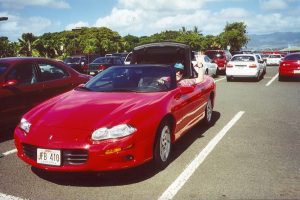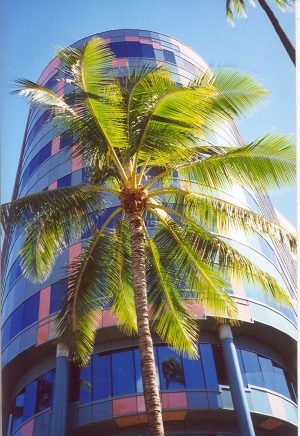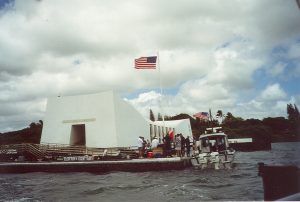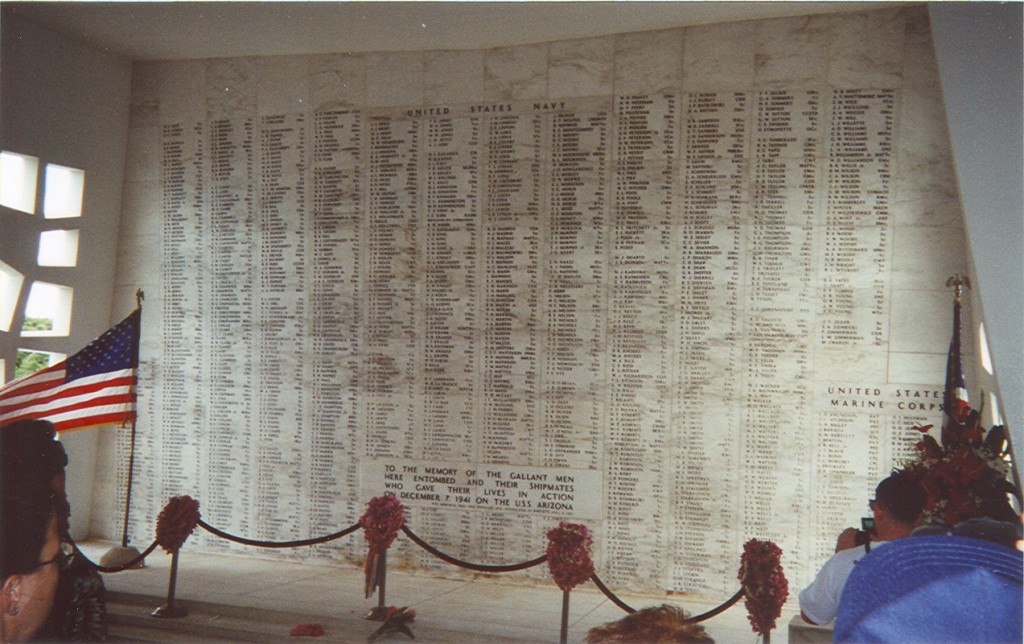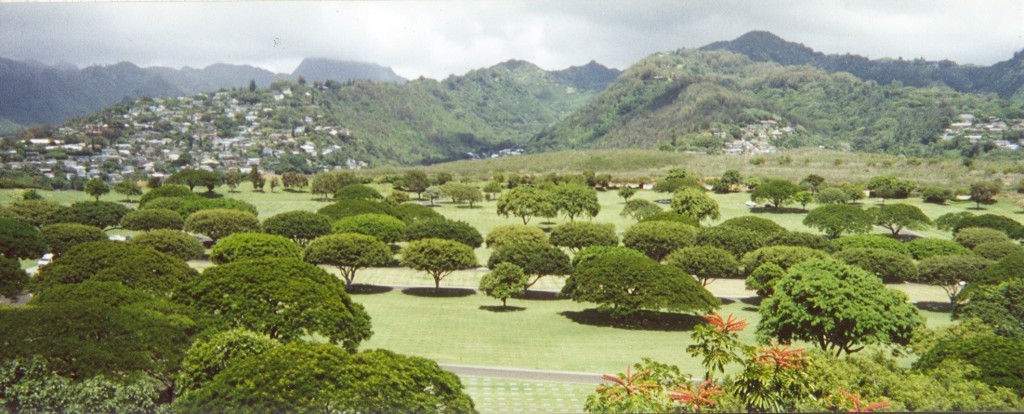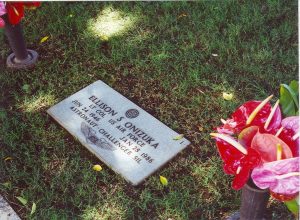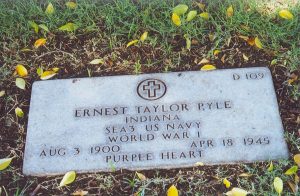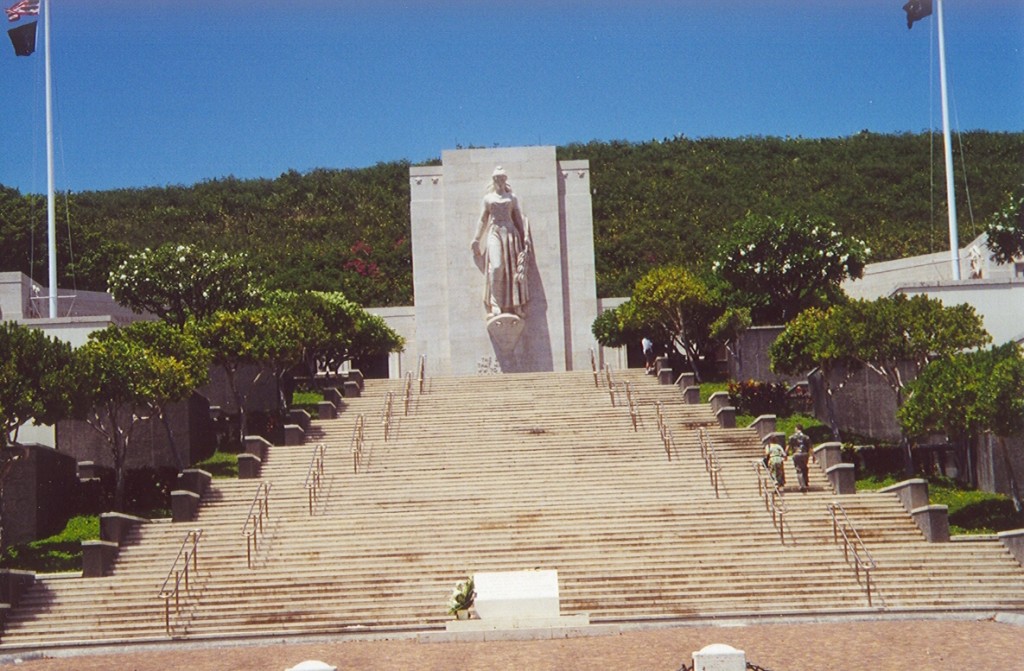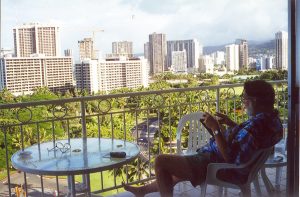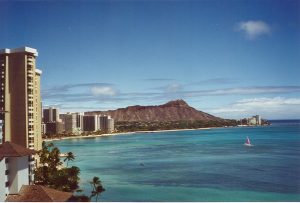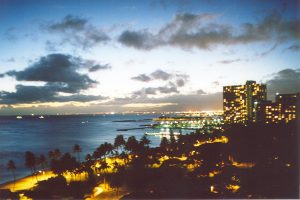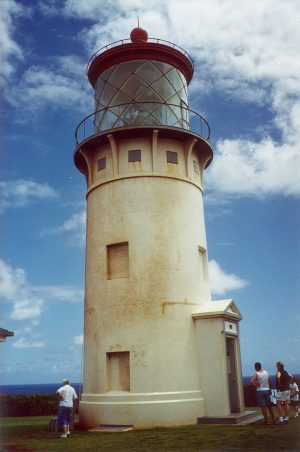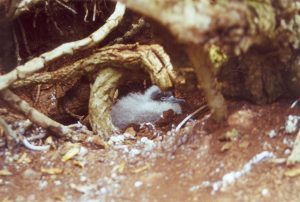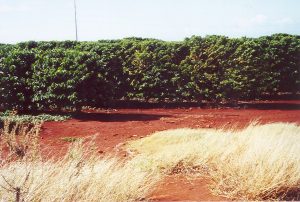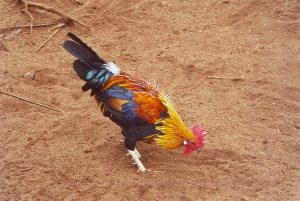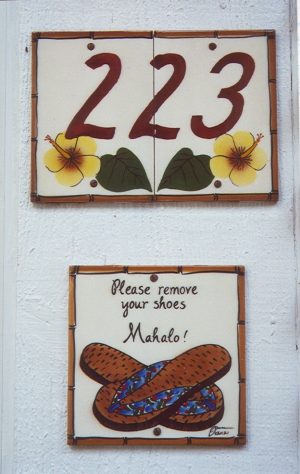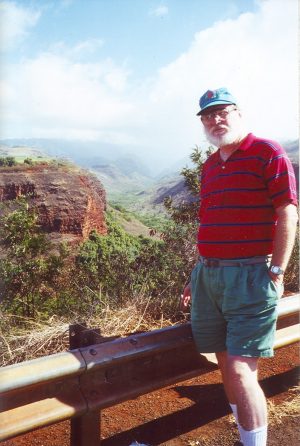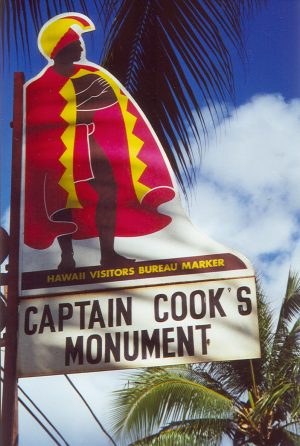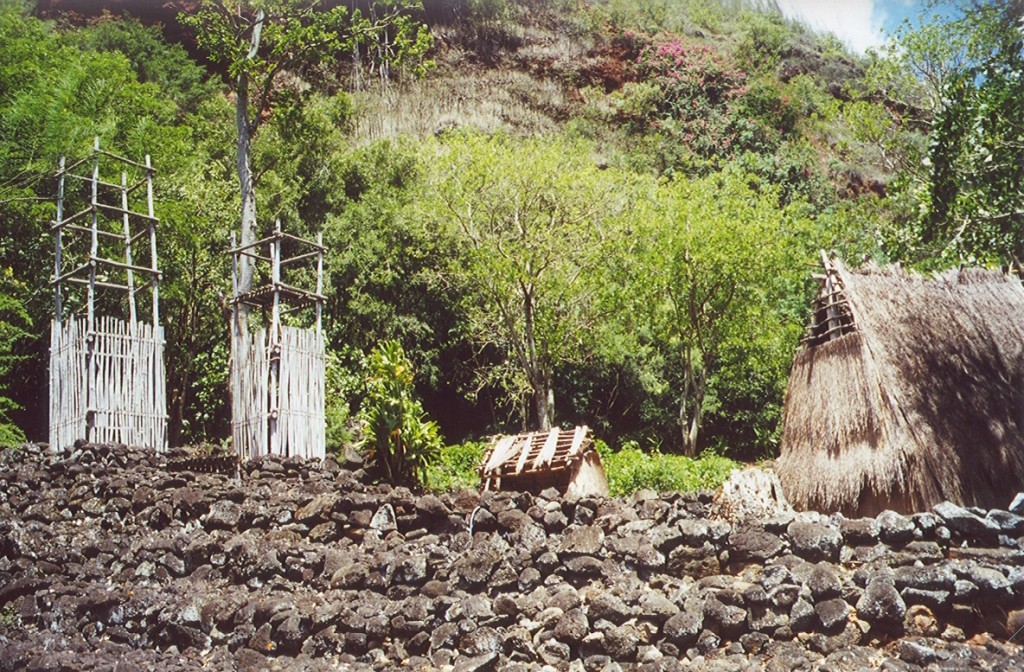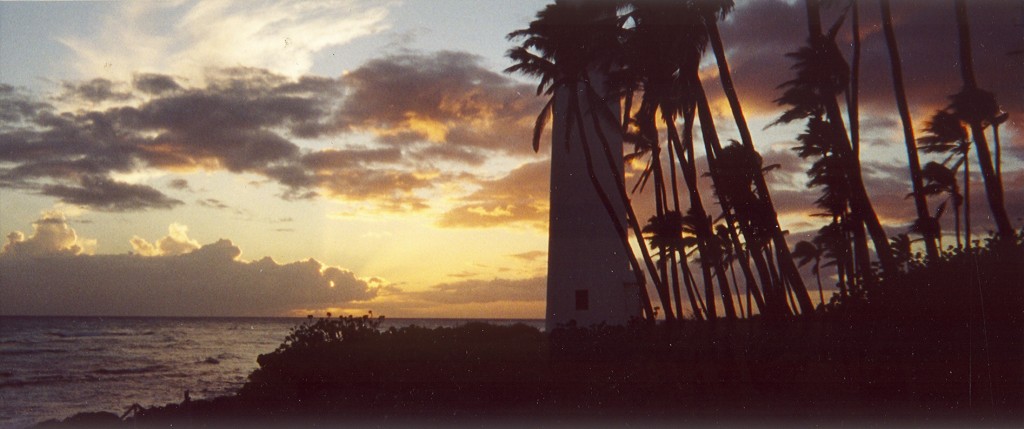A few months ago Lee’s Mom, Helen, told us she’d like to take us to Hawaii again, as she did three years ago. That time we went to Maui, this time it would be Oahu and Kauai. I knew nothing about Kauai, but Oahu … Where do you start? How much can you see in four days on Oahu?
Lee’s brother, Tim, was also going, and they made all the arrangements. Lee and I decided to rent a car on Oahu, and figured, What the hell? Why not rent a convertible? It cost about 50% more than a standard full-size.
At the car rental desk at the airport the agent told me he had three Camaros, in teal, black, or red. Does anyone think I had any real choice? Got to be red. Soon I was puttering down the Nimitz highway with the top down and what sounded like heavy-metal Hawaiian music thundering on the radio. (Later I heard some Hawaiian Rap.) I say puttering because, as I quickly discovered, just about the only place on the island worthy of my car was the H-1 at about three in the morning. Otherwise, forget about it. Traffic was as bad as I’ve ever seen, anywhere. I usually crawled at 5 or 10 mph in the city, and 50 was about the most you could expect in the country.
Okay, that’s not completely true. There were a few moments when the road was clear and I could jam the accelerator a bit, see just how lively the car was … and I learned a sad fact which I will share with you. Camaros aren’t what they used to be. I suspect that NONE of those low, sleek, aerodynamic cars we’ve been seeing more and more of in recent years are half the car they appear to be, unless you’re talking Ferrari or Lamborghini.
The last time I drove a Camaro was in the early 80s, while working on the nth rewrite of Millennium. For some reason the studio gave me a yellow Camaro to drive for a few weeks in Los Angeles instead of the usual full-size Chevy. You didn’t so much get into it as strap it on. The hood was so long you felt that no sooner had you got on the freeway at Century Boulevard than you’d better start thinking about turning the front wheels to exit at Santa Monica. I remember it was the year that Neil Young brought out what was a fairly experimental album for the time, called Trans, full of synthesizers, sounding a little like DEVO. I bought the tape at Tower Records in Westwood and drove all over SoCal in that Camaro, an electronic version of “Mr. Soul” blasting away on the tape deck. When I pressed the accelerator I could hear the seatback creak as I was pressed against it. I would be doing 90 in seconds. Quite a car.
The Camaro was fun in Hawaii, it was great to be able to see the tops of the tall buildings as we drove around … but it really wasn’t the car for a party of four. There was about enough room in the back seat for a small suitcase and a map or two. Certainly not comfortable for Tim and Lee. Sorry about that.
* * *
Honolulu reminds me a little of Miami. Both are big cities in tropical climates, both are oriented to the beautiful oceans and beaches. And both are pretty bilingual. But in Honolulu the second language is Japanese. Our elevator door opens: a Japanese family, smiling and bowing. Signs on the street are sub-titled in Japanese. Many are tourists, many are American citizens. (EVERYONE in Hawaii is in a minority, but the Japanese are one of the largest minorities.) Japanese citizens visit the Islands at about half the rate mainland Americans do … but they spend twice the money, per head. If all the Japanese tourists stopped coming they’d have to put Waikiki in mothballs until they came back.
They’re everywhere. Including Pearl Harbor…
Now, I feel it is way past time to let bygones be bygones. Former enemies have met and shaken hands many times, sometimes right here on the monument suspended over the wreckage of the USS ARIZONA, above 1,177 dead American sailors and marines. The nation of Japan is our ally, our friend … so far as it is possible for nations to be friends. (This is distinct from the Empire of Japan, which still has millions of deaths to answer for, and which the democratic nation of Japan continues to deny or minimize. For these things, forgiveness is impossible.) Still, it’s odd to see them there, relentlessly posing and snapping pictures …
What a moving place. It gave me goose bumps. We didn’t have time to visit the USS MISSOURI, just down the dock at Ford Island. But we didn’t have to. There it was, huge and gray. We stood on the place where American involvement in the Pacific War began … and looked a few hundred yards to the place where it ended.
There’s another place to see a lot of Japanese, though these are not as lively as the tourists. They are Japanese names, anyway, though they are all American citizens. The names are on headstones at the military cemetery at the Punchbowl, which is a volcanic crater just up the hill from downtown Honolulu.
About 25,000 American soldiers lie there in as pretty a setting as you could ask for. The two best known are the soldier/journalist, Ernie Pyle, and Ellison Onizuka, who died in the explosion of the Space Shuttle Challenger. We looked up their location, found they were buried in the same section. When we got there, I noticed hundreds of Japanese names on the stones. Name after name, most of them from the 442nd Regimental Combat Team, the all-Nisei unit who proved they could fight and die better than any white American soldiers even though their families were in concentration camps in the western American deserts. I estimated 600 graves. Segregated even at the end, it seemed.
- Ellison S Onizuka
- Ernie Pyle
Then we went to the monument to the missing – 26,000 names – and unknowns, and to other sections of the cemetery. More and more Japanese names. Now, of course, this was Hawaii, where you’d expect a larger than normal Japanese contingent. Still … it was a lot of yellow-skinned boys dying for their country.
* * *
Hawaiians don’t seem to suffer from triskaidekaphobia. (That word isn’t in my WORD 97 spellchecker, but it means “fear of the number 13.”) When we checked in to our Honolulu accommodations we found we were staying on the 13th floor. So far as I can recall, I don’t think I’ve ever even been on a 13th floor. They’re pretty rare.
We were at the Outrigger Waikiki Shores, right next to the Outrigger Reef. Outrigger is a chain of hotels and condos all over the islands. The Reef was a huge resort hotel that towered over the Shores, a relatively small condo building (15 stories) on the edge of a park. The Reef didn’t block our view, though; it was behind us. From our lanai we could see the western part of the beach, the sea, big buildings just beyond the park across the street. We looked down on the roof of a military museum, which we didn’t have time to visit. There were some tanks, a helicopter, and shore gun emplacements still pointing out to sea, waiting for the Japanese invasion. Of course, today, 59 years later, the guns are pointed the wrong way…
I can’t find too much useful to say about Waikiki. People from as recently as the 1950s would be astonished. They would have a hard time finding the beach. There are signs pointing the way between the concrete behemoths that arrogantly block off all sight of the ocean, the better to have more rooms with ocean views. In Hawaii, “garden view” means you can’t see the water from your window. But “ocean view” doesn’t have to mean you can see crashing surf. It can mean that if you lean far out your window and hold a mirror out there, you might see a few square inches of blue.
Tourism on this scale didn’t become possible until the age of the intercontinental jet. I’m sure that many, many Hawaiians wish those jets had never been invented. I won’t complain about it, though, since I like cities. But they really HAVE to do something about the traffic. It is the worst I’ve ever seen. And it wouldn’t hurt if they’d post street numbers prominently on their buildings. I had to circle the block five times before I figured out where the Waikiki Shores was.
Some Hawaiian architecture seemed a little weird to me. Our neighbor, the Outrigger Reef Hotel, didn’t have any front doors. It didn’t have any walls at all to separate it from the outdoors. You walked from the sidewalk through a wide open area and there was the front desk. They must have a way to button it up in case of a typhoon, but I didn’t see it.
* * *
We drove most of the way around Kauai to the little town of Hanalei. It looked somewhat different than the other towns we’d seen. Though the town was spiffed up in a touristy way, and clearly made its living from tourist bucks, there was more of what I think of as Old Hawaii in evidence. This means there were a lot of square, wooden buildings sitting up on blocks or stilts, often painted green, with rusty tin roofs. It was easy to contrast Hanalei with the monstrous development we drove by to get there, a “planned community” called Princeville. We didn’t bother to go there. Driving by the guard post and seeing a glimpse of gigantic houses and acres and acres of golf course told us all we needed to know about Princeville. A few miles apart, Hanalei and Princeville couldn’t have been more different.
Turns out there was a reason for that. I read about it in my guidebook that evening, when we got back to the condo. (I know, I know, you’re supposed to read the guidebook BEFORE you go to a place, but I find the information doesn’t mean much to me until I get there and look around.) As we rounded the last curve before Hanalei we were confronted by a narrow iron trestle bridge. When I say narrow, I’m talking one-way. As we crawled over it I noted with bemusement that the trestle was pretty badly eroded. Then I further noted, with perhaps a little alarm, that some of the girders were actually rusted clean through. Jeez! Why don’t they fix it?
That bridge is a battle line. Beyond it are five or six miles of country road, with six more narrow, dilapidated bridges before the paved road ends at the Na Pali cliffs. There are many people who would do almost ANYTHING to upgrade that road and replace those old bridges with new, wide, modern spans … so they could re-make those last miles in the image of Princeville. BUT, as the residents of this last unspoiled stretch of road are aware, heavy earthmoving equipment and cement mixers and tourist buses and big trucks of all kinds can’t make it over that first bridge. Clearly, it would soon collapse. The residents of Hanalei and beyond have been fighting for years to keep their old bridges. So far, they’ve won.
Funny to think of that decrepit old relic as a rampart in the crusade to save Hawaii from becoming five island-spanning golf courses …
I view golf as a plague upon the land. Aye, lads and lassies, those bagpipe-puffing, skirt-wearing bastards in Scotland will have a lot to answer for some day for inflicting their ridiculous “sport” on an unprepared planet. They should be doomed to endlessly play an 18-million-hole course in hell, each hole a 5000 yard par 3.
But I understand that in recent years, many, many acres of land that used to grow pineapple and sugar have not been planted due to competition from other nations like the Philippines. Resort developers are buying them up … and the new golf courses already on the drawing boards will soon DOUBLE the number of acres wasted by a lot of old duffers in loud shirts whacking a little white ball around and chasing after it in electric carts and calling it exercise …
* * *
Sometimes not reading the guide book works out okay after all. Not long before Hanalei, at Kilauea Point, there is a lighthouse that looked like a good photo-op. It was, but once we got there we hardly looked at the lighthouse. The Point was also a breeding ground for four types of seabirds. Across a churning inlet we could see thousands of red-footed boobies sitting their nests. But on the Point itself, literally right under our feet, there were thousands of wedge-tailed shearwaters in their underground nests. Not the adults, who were at sea getting lunch, but the fuzzy gray chicks, hunkered at the end of short tunnels, dozing as they waiting for mom and pop to arrive and upchuck some nice, warm, half-digested fish. They were supposed to dig in the side of the cliff, where we could look down and see pieces of PVC pipe put there to help them out. But perversely, many had dug into smaller humps of dirt right along that path. And best of all, the powers that be allowed people to get close enough to those nests to actually see the chicks. Apparently people don’t bother them much.
On the way out we saw two almost-extinct nene geese, the state bird of Hawaii.
* * *
When I learned that the Hawaiian language had only twelve letters, I was tempted to think of it as primitive. You know, sort of a Language Lite. But simplicity has its own attractions. The more I learned, the better I liked it. Pronunciation is pretty standard, it seems, and not difficult to learn, unlike English, whose pronunciations are NOT intuitive or standardized, and which is encrusted with useless and stupid barnacles like –ght. Where did THAT come from? You can’t help but wonder. (A friend of mine claimed it came from Dutch typesetters, who used their own rules when they had a contract in English.) In English, every rule has its exception, usually a stupid exception.
But look at Hawaiian. I don’t know if anyone ever built one, but a Hawaiian typewriter would be a thing of beauty. You could put the five vowels and W under one hand, and the other six consonants under the other. Twelve keys, then add a second row for punctuation. Why, if we all had twelve fingers (as some people actually do) we wouldn’t even have to move them from key to key. Take it even further: we could all switch to a duodecimal system, base 12, and use the 12 letters of the alphabet as numbers. It would be a more logical and easy-to-learn universal language than Esperanto.
There ARE a few things that would take some learning, though. My book says that the pronunciation of diphthongs, and the use of glottal stops (written as apostrophes, so that you sometimes see the state written as Hawai’i) and macrons (a line over a vowel to stress it) can lead to some confusion for a novice. The word “ai,” for instance, can mean “to eat” or “sexual intercourse,” depending on the pronunciation. Though I can’t help wondering if, early on, some prudish missionary misunderstood the Hawaiian word for “oral sex.”
* * *
I had thought that, since you pronounce each vowel separately, Kauai would be pronounced Kah-oo-AH-ee, but everybody seemed to say it something like COW-eye, so I did, too. They call it the Garden Island. I had thought that was Lanai. It’s sure green enough, and there’s flowers everywhere you look, but that’s true of at least part of all the islands, except maybe Niihau.
I would have called it the Red Dirt Island, or maybe Chicken Island. The red dirt is very red, and makes a fine dust that coats everything near a road. They even sell “Dirty Shirts,” the same color as the dirt. That way no one can tell if you’re really dirty. Truth. (Some Kauaiians have WAY too much time on their hands.)
Chickens probably first came over with the original Hawaiians. But in the early 80’s a hurricane knocked over a lot of coops containing Cuban fighting game cocks, and the chickenshit really hit the pupu platter. They interbred with the native chickens. Now they’re everywhere, scratching beside all the roads, along the beaches, even at the top of the Waimea Canyon, and if they keep increasing for another decade or two they could become a real problem. They are beautiful birds, especially the roosters, multicolored and long-feathered. But one day we went to Safeway to buy some chicken breasts for dinner … and the FROZEN ones cost $5.99/pound. At that price, I figured that if I ever came to live on Kauai, I’d learn to wring wild chicken necks.
We stayed at a condo on Kauai. It was owned by a couple who called it their home away from home, and who let the condo management rent it out when they were away. They left a blank book behind, inviting tenants to register their comments.
Most waxed enthusiastic about the things you’d pretty much expect them to gush about. A few were there at the wrong season, and carped about the rain. Hey, everybody wants their Hawaiian vacation to have good weather (we encountered only a few sprinkles), but rain or shine, it’s a great place, and most people seemed to agree.
But a few entries were worthy of note. Like this one:
Oh my God! I never want to leave I met the most hottest guy in the whole world Tommy. And all my life I have been waiting for a Tommy because the song Katie and Tommy. Needless to say my name is Katie.
Needless to say, indeed. For some reason, the only song I can recall like that is “Frankie and Johnny.” Does anybody know what song she’s talking about?
Then there was the nameless poet who offered this charming haiku:
Fragrantly it comes
The plumeria rushes
Fills the air softly
Plumeria is a tree that looks like a rhododendron and has blossoms frequently – and fragrantly – used in leis.
There was one other poet, who left this plaintive verse:
I am a pizza
Covered in cheese
No anchovies
Pepperoni
I am a pizza –
Please take me home
* * *
So, we fly to Hawaii, and what are two of the most impressive things we saw? Would you believe … cactus, and a canyon? For a while I wondered if we’d lost our way and gotten dropped off in Arizona.
Waimea Canyon looks like the Grand Canyon might look if it got a couple hundred inches of rain every year. Stratified towers of rock with tropical vegetation clinging every place it can get a roothold. A rushing river at the bottom. But a lot of it is illusory. It’s not nearly as wide or as deep as the Grand Canyon, of course. Some of the sense of hugeness is an optical illusion. But more to the point, it’s not nearly so old. The rocks at the bottom of the Grand Canyon are about two billion years old. The whole island of Kauai is only 6 million years old. So why does it erode so quickly? Lots more water, for one thing. A few miles away is what they claim to be the Rainiest Spot on Earth: 486 inches per year. For another, I found I could pick at the layered rock with my fingers and it broke off like dried clay, which, I guess, is what it was.
The cactus was in a garden at the Kiahuna Plantation at Poipu, where we stayed. They had a cactus garden that covered a couple of acres. I have no idea if much cactus ever grew naturally in the islands, but an amazing assortment was thriving there in the garden. Who knew?
* * *
A lot of what I’ve learned about Hawaii came from the Lonely Planet travel guide. I grew to love this company when my sister Kerry and I went around the world years ago. I bought LP guides to Australia and India and found them endlessly helpful. The company has grown immensely since then, and there’s a guide for just about anywhere you’d like to go and plenty of places you’d be better off avoiding. I even sold a story reprint to them, “In the Bowl,” for a book about travel through the Solar System.
The following story came from the LP Guide to Hawaii, though the words are mine:
Hawaii is thought to have been first settled by people from the Marquesas Islands in 500 to 700 AD. They got their butts kicked by invading Tahitians in 1000. Then a Big Kahuna named Paao arrived in 1200. He must have had some mighty big kahunas on him, because he revolutionized the religion of the islanders. He introduced human sacrifice. Infractions as silly as allowing your shadow to fall on the King was a capital offense. He also instituted a complex system of sexual taboos, called kapu, to the point that men and women couldn’t even eat together, or share some of the same foods.
And there things stood for 600 years. Remember that number.
Captain Cook, whalers, missionaries, and sandalwood traders arrived at various times beginning in 1778, bringing the usual wonders and gifts of the white man: cholera, Catholicism, smallpox, firearms, James Michener, leprosy, Congregationalists, the clap. (The Hawaiians managed to kill Cook, but didn’t have much luck with the rest. The many benefits of capitalism, civilization, and Christianity managed to reduce the native population from about 300,000 in 1800 to 50,000 by the time the country was basically stolen from the Hawaiian monarchy by a bunch of sugar barons in 1893.) But before that, King Kamehameha united the islands under his rule. King K died in 1819, was succeeded by his son Liholiho who, like so many sons of very strong kings, didn’t want the job, wasn’t up to it. The real power was Kaahumanu, King K’s favorite of his 21 wives. I’d like to learn more about Lady K; she sounds like she could have given Susan B. Anthony lessons in the pursuit of suffrage. She threw a big party for all the female royalty and forced Liholiho to sit down and eat with them.
… and poof, just like that, it was all over. Six hundred years of religion and custom. Everybody ran around for a while smashing temples and burning idols. And, as luck would have it, the very next year the missionaries started arriving, and moved into the sudden vacuum in the God business.
I read this, and I thought, Wha…..?
I mean, think about it. This isn’t the Catholic Church suddenly saying it’s okay to eat meat on Fridays and you don’t have to pray for infants in limbo anymore. It’s not even like the collapse of communism in Russia and Eastern Europe after 70 years. One little dinner party … and SIX HUNDRED YEARS of tradition are suddenly in the crapper.
Say the Chief Rabbi of the Hasidic Jews gets up one morning and says to his wife, “Oy! What a schmuck I’ve been! This kosher business, what nonsense! It’s a pain in my Talmudic ass! Fix me a big plate of bacon and eggs!” Pretty soon Israel is the world’s largest consumer of pork bellies. Young Hasidim are sporting electric blue sideburns and nose rings and baggy pants, slam-dancing to the wild strains of punk klezmer music.
What if Billy Graham suddenly announced “Listen to me, all you cats and kitties! I’ve been thinking about it, and this Satan dude really has his mojo workin’! I dig the licks that cat is laying down! God is a loser! He chaps my evangelical ass! From now on, it’s Devil worship for me! Hail, Lucifer!” And all the Baptists start holding buck naked black masses out in the piney woods. (A truly horrifying thought, considering some of the Baptists I’ve known …)
Or picture this: In the Vatican, JP2 starts passing out condoms with the consecrated host. Then he hurls his Sydney-Opera-House hat into the Sistine Chapel trash bin with the Michelangelo fresco on it, grabs a nun by the ass, and cackles. “I’m outta here!” he shouts. “Father, Son, and Holy Ghost? What a crock! What an ecclesiastical asshole I’ve been! Live for today! Enjoy yourself! Make money! I’m grabbin’ my boogie board and hittin’ the slopes while I can still stand up!” Next week the Church in Mexico liquidates all its holdings and distributes the money to the peasants, who are soon day-trading on the ‘Net, rich as the Swiss. In Italy, everybody divorces everybody else all at once. In Ireland, the people are at long last free to blaspheme, carouse, drink until they puke, screw sheep, write obscure and depressing novels and … okay, okay, so nothing would really change much in Ireland …
* * *
All in all, quite a nice trip. My lifelong problem – in Hawaii we could call it Kilauea’s Revenge – had me doing the Wiki-wiki Quickstep a couple of times, but never at a time when a rest room wasn’t near at hand. That counts for a lot, let me tell you.
See you next time. Mahalo. Aloha.
September 16, 2000
Sauvie Island, OR

